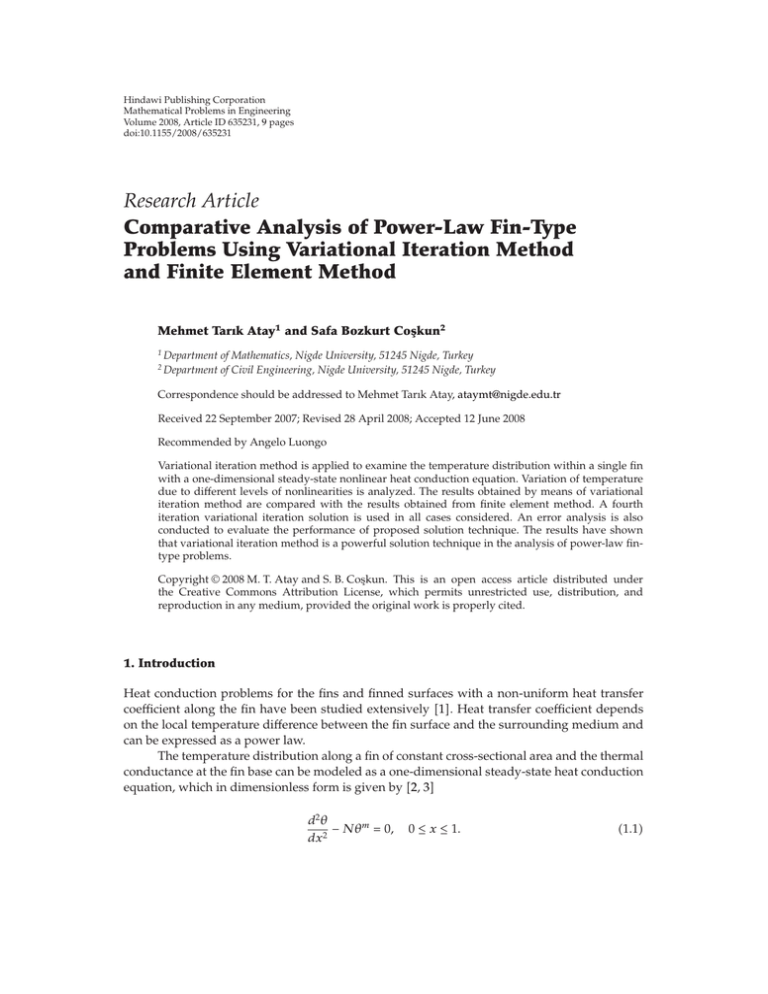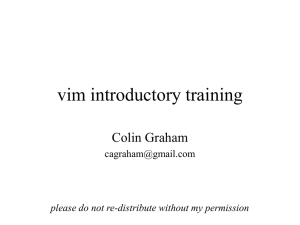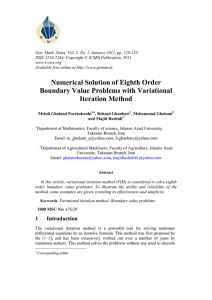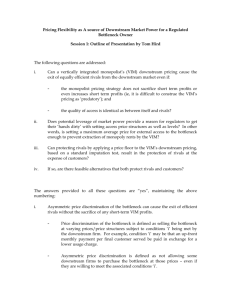Hindawi Publishing Corporation Mathematical Problems in Engineering Volume 2008, Article ID 635231, pages
advertisement

Hindawi Publishing Corporation Mathematical Problems in Engineering Volume 2008, Article ID 635231, 9 pages doi:10.1155/2008/635231 Research Article Comparative Analysis of Power-Law Fin-Type Problems Using Variational Iteration Method and Finite Element Method Mehmet Tarık Atay1 and Safa Bozkurt Coşkun2 1 2 Department of Mathematics, Nigde University, 51245 Nigde, Turkey Department of Civil Engineering, Nigde University, 51245 Nigde, Turkey Correspondence should be addressed to Mehmet Tarık Atay, ataymt@nigde.edu.tr Received 22 September 2007; Revised 28 April 2008; Accepted 12 June 2008 Recommended by Angelo Luongo Variational iteration method is applied to examine the temperature distribution within a single fin with a one-dimensional steady-state nonlinear heat conduction equation. Variation of temperature due to different levels of nonlinearities is analyzed. The results obtained by means of variational iteration method are compared with the results obtained from finite element method. A fourth iteration variational iteration solution is used in all cases considered. An error analysis is also conducted to evaluate the performance of proposed solution technique. The results have shown that variational iteration method is a powerful solution technique in the analysis of power-law fintype problems. Copyright q 2008 M. T. Atay and S. B. Coşkun. This is an open access article distributed under the Creative Commons Attribution License, which permits unrestricted use, distribution, and reproduction in any medium, provided the original work is properly cited. 1. Introduction Heat conduction problems for the fins and finned surfaces with a non-uniform heat transfer coefficient along the fin have been studied extensively 1. Heat transfer coefficient depends on the local temperature difference between the fin surface and the surrounding medium and can be expressed as a power law. The temperature distribution along a fin of constant cross-sectional area and the thermal conductance at the fin base can be modeled as a one-dimensional steady-state heat conduction equation, which in dimensionless form is given by 2, 3 d2 θ − Nθ m 0, dx2 0 ≤ x ≤ 1. 1.1 2 Mathematical Problems in Engineering L Tb b Te X Figure 1: Geometry of one-dimensional heat conduction problem in a straight fin. Subjected to following boundary conditions: θ 0 0, θ1 1, 1.2 where the differentiation is with respect to the dimensionless coordinate x, measured along the fin length from its adiabatic and θ is the dimensionless temperature, N is the convectiveconductive parameter of the fin and the exponent m depends on the heat transfer mode. Physical values of the power m of some practical interest are related to free convection, nucleate boiling and radiation. Some physical cases are defined in 2 with the geometry of 1/2 the problem. For example, for the convecting fin problem m 1, N 2hL2 /bk , θ T −Te /T −Tb , x X/L, and for the fin radiating to the zero environment temperature m 4, 1/2 N 2ETb3 L2 /bk , θ T/Tb , x X/L where E is emissivity, h is heat transfer coefficient, L is fin length, T is temperature, Tb is fin base temperature, Te environment temperature, b is fin thickness, k is thermal conductivity, and X is distance from fin tip. The problem is depicted in Figure 1. The role of the fin-tip heat transfer has been comprehensively studied in 4 and hence to avoid additional parameters in the current problem, only the case of a fin with an insulated tip, see 1.2, is considered in this paper. The problem governed by 1.1-1.2 possesses an analytical solutions for certain values of m 3, 5–9. The analytical solution given in 5 includes a three-parameter hyper geometric function, and also a Dawson’s integral in 3. Previously, fin-type problems have been solved by using different methods of analysis. Yu and Chen 10 used Taylor transformation method to optimize rectangular fins with variable thermal parameters. Yu and Chen 11 used differential transformation method for circular fins with variable thermal parameter. Chiu and Chen 12 used decomposition method for the analysis of circular fins. Arslantürk 13, 14 applied Adomian decomposition method successfully for the analysis of convective fins and space radiators. Lesnic and Heggs 15 also used Adomian decomposition method for power-law fin-type problems. In recent years a solution technique called variational iteration method VIM 16 has been given great importance for solving nonlinear differential equations. VIM is a kind of variational-based analytical technique in efficient solution of nonlinear differential equations including boundary value and initial value problems, nonlinear system of differential equations, nonlinear partial differential equations 17–19. Coşkun and Atay 20, 21 used VIM for the analysis of convective straight and radial fins with temperature-dependent thermal conductivity and examined the effect of temperature-dependent thermal conductivity considering various cases. These successful applications of the method to the fin-type problems are the reasons for choosing VIM in present problem. M. T. Atay and S. B. Coşkun 3 VIM directly gives the solution of corresponding equation which is one of its advantages when compared to ADM. The formulation and solution process of VIM is much easier when compared to decomposition methods, in this respect; VIM is an easy-to-apply method for the analysis of nonlinear problems in engineering. In this study, power-law fin-type problems will be analyzed using VIM. In the analysis, the effects of convective-conductive parameter of the fin N and exponent of the powerlaw fin-type m which corresponds to heat transfer mode will be studied in detail. An error analysis will also be conducted by comparing VIM results with the finite element solution of the same equation. 2. VIM formulation of the problem According to VIM, the following differential equation may be considered: Lu Nu gx, 2.1 where L is a linear operator, N is a nonlinear operator, and gx is an inhomogeneous term. Based on VIM, a correct functional can be constructed as follows: x un1 x un x λξ Lun τ N u n τ − gτ dτ, 2.2 0 where λ is a general Lagrangian multiplier, which can be identified optimally via the variational theory, the subscript n denotes the nth-order approximation, u is considered as a restricted variation, that is, δ u 0. By using this formulation, a differential equation for obtaining the Lagrangial multiplier λξ is λ ξ 0 2.3 with corresponding conditions, λξ|ξx 0, 1 − λ ξ|ξx 0. 2.4 By solving 2.3 with respect to boundary conditions in 2.4, Lagrangial multiplier λξ is obtained as follows: λξ ξ − x. 2.5 If the above VIM formulation is applied to 1.1, following iteration formula can be obtained accordingly: x θn1 x θn x λξ θn ξ − N θnm ξ dξ, 2.6 0 where N is previously defined as nonlinear operator in 2.1. Lagrange multiplier λ is obtained as follows by assuming that L d2 /dξ 2 with the restricted variation δ u n 0. The iteration formula given in 2.6 is a simple approximation when compared to ADM formulation of the same problem 14. This is due to the fact that new formulation directly gives the expression instead of summing recursive approximations which is a tedious work. 4 Mathematical Problems in Engineering 3. Solutions for fin temperature distribution As a starting approximation for VIM solution, θ is assumed as constant, which was assumed as constant also in ADM solution 14. For simplicity, first few iterations of VIM corresponding to N 1 with m 2, 3, 4 are presented. For N 1, m 2, first three iterations are 3.1a θ0 x B, 2 2 B x , 2 B 2 x2 θ2 x B 2 2 2 B x θ3 x B 2 θ1 x B 3.1b B 3 x4 B 4 x6 , 12 120 3 4 4 6 B x B x B 5 x8 11B 6 x10 B 7 x12 B 8 x14 . 12 72 560 64800 95040 2620800 3.1c 3.1d For N 1, m 3, first three iterations are 3.2a θ0 x B, 3 2 B x , 2 3 2 B 5 x4 B 7 x6 B 9 x8 B x , θ2 x B 2 8 40 448 B 3 x2 B 5 x4 3B 7 x6 23B 9 x8 83B 11 x10 101B 13 x12 θ3 x B ··· . 2 8 80 2240 33600 197120 θ1 x B 3.2b 3.2c 3.2d For N 1, m 4, first three iterations are 3.3a θ0 x B, 4 2 B x , 2 B 4 x2 B 7 x4 B 10 x6 B 13 x8 B 16 x10 θ2 x B , 2 6 20 112 1440 B 4 x2 B 7 x4 13B 10 x6 17B 13 x8 1789B 16 x10 701B 19 x12 ··· . θ3 x B 2 6 180 560 151200 166320 θ1 x B 3.3b 3.3c 3.3d Analysis of the problem is conducted for N 0.1, 0.5, 1, 2, 5 with m 2, 3, 4 for each N up to fourth iteration of θθ4 x. By using these parameters, the effect of increasing convectiveconductive parameter of the fin N and exponent of the power-law fin-type m which corresponds to heat transfer mode is studied. These parameters cause nonlinearity in 1.1. Hence, with the performed analysis, the effect of degree of nonlinearity in the solution of this equation is examined. For this purpose an error criterion is defined and calculated for each case by using the finite element solution of the equation and VIM solution with fourth iteration. Error criterion is defined as n 1/2 2 I1 |θFEM − θVIM | Error , 3.4 n 2 I1 |θFEM | where θFEM is the finite element solution, θVIM is the fourth iteration VIM solution, and n is the number of points where the solution is considered. M. T. Atay and S. B. Coşkun 5 1 N 0.1 0.99 0.98 θ 0.97 0.96 0.95 0 0.2 0.4 0.6 0.8 1 x m 2 FEM m 3 FEM m 4 FEM m 2 VIM m 3 VIM m 4 VIM Figure 2: Dimensionless temperature distribution for convective-conductive parameter N 0.1. 4. Numerical results Proposed solution technique is applied for different cases explained in previous section. These different parameters represent the degree of nonlinearity in the corresponding equation. In this study, finite element solutions of 1.1 are obtained using the software FlexPDE Version 5. In finite element analysis quadratic basis functions are used and a modified Newton-Raphson algorithm is employed with a root mean square error criterion of order 10−7 or less to solve nonlinear set of resulting equations. First, the problem is solved for small values of convective-conductive parameter N with varying m values. To this aim, N is chosen as 0.1 and 0.5. Figure 2 shows the variation of θ with respect to x for N 0.1. From the figure it seems that VIM solution is in excellent agreement with FEM solutions. From Figure 8, a very small error of order 10−8 can be observed. For N 0.5, the results produced by using both methods are shown in Figure 3. Again, an excellent agreement can be seen from this figure with the same order of errors as in previous case. At the next stage, the analysis is conducted for N 1 and N 2. Figures 4 and 5 show the results obtained for these cases. From the graphs the results obtained from both methods are still in very good agreement, however as shown in Figures 7 and 8 errors are increased gradually for these cases when compared to first two cases. Last case study is performed for N 5 with the same m values. The results are shown in Figure 6. From the analysis, it can be observed that VIM and FEM results are still in good agreement but maximum errors are obtained as it can be seen form Figures 7 and 8 for this case when compared to previous cases. Case studies have shown that increasing nonlinearity due to the increasing parameters N and m resulted in increasing error values. However, obtained VIM results are still in good agreement with the FEM results even for the maximum values of N and m considered. In order to show the effect of nonlinearity in the solutions obtained, two different error analyses are conducted with respect to N and m parameters. In all cases considered, a fourth iteration solution in VIM analysis is used. From Figure 7, it can be observed that errors increase 6 Mathematical Problems in Engineering 1 N 0.5 0.96 0.92 θ 0.88 0.84 0.8 0 0.2 0.4 0.6 0.8 1 x m 2 FEM m 3 FEM m 4 FEM m 2 VIM m 3 VIM m 4 VIM Figure 3: Dimensionless temperature distribution for convective-conductive parameter N 0.5. 1 N1 0.95 0.9 θ 0.85 0.8 0.75 0.7 0 0.2 0.4 0.6 0.8 1 x m 2 FEM m 3 FEM m 4 FEM m 2 VIM m 3 VIM m 4 VIM Figure 4: Dimensionless temperature distribution for convective-conductive parameter N 1. 1 N2 0.95 0.9 0.85 θ 0.8 0.75 0.7 0.65 0.6 0.55 0 0.2 0.4 0.6 0.8 1 x m 2 FEM m 3 FEM m 4 FEM m 2 VIM m 3 VIM m 4 VIM Figure 5: Dimensionless temperature distribution for convective-conductive parameter N 2. M. T. Atay and S. B. Coşkun 7 1 N5 0.9 0.8 θ 0.7 0.6 0.5 0.4 0.3 0 0.2 0.4 0.6 0.8 1 x m 2 FEM m 3 FEM m 4 FEM m 2 VIM m 3 VIM m 4 VIM Figure 6: Dimensionless temperature distribution for convective-conductive parameter N 5. 1E − 03 Error 1E − 04 1E − 05 1E − 06 1E − 07 1E − 08 2 3 m 4 N2 N5 N 0.1 N 0.5 N1 Figure 7: Variation of errors with respect to heat transfer mode m for different convective-conductive parameters N. 1E − 03 Error 1E − 04 1E − 05 1E − 06 1E − 07 1E − 08 0.1 0.5 1 N 2 5 m2 m3 m4 Figure 8: Variation of errors with respect to convective-conductive parameter N for different heat transfer modes m. 8 Mathematical Problems in Engineering with increasing m for each N values. Also, maximum errors are obtained for maximum N value N 5. Figure 8 describes variation of error with respect to N for different m values. From the graph, it can be observed that error increases with increasing N even though N is a constant value. Equation 1.1 includes a nonlinear term multiplied by this constant N. Figure 8 shows that N has a significant effect on the solution of the governing equation given in 1.1. Hence, with the increasing multiplier for the nonlinear term in 1.1, more iteration may be required for an accurate analysis. However, fourth iteration VIM solution used in this study is accurate enough for the analysis of the problem with the values considered in this study. 5. Conclusions In this paper, power-law fin-type problems have been considered. The nonlinear fin equation has been solved by using the VIM which provides an analytical expression converging to the solution of the governing equation. These results were compared with the FEM results of the same equation and the effect of nonlinearity due to the convective-conductive parameter of the fin N and exponent of the power-law fin-type m has been analyzed. The results have shown that VIM can be efficiently used in the analysis of power-law fin-type problems and another remarkable point is that the analysis with VIM requires not much effort with respect to formulation of the problem and iteration required. An additional important point is that the error obtained has been increased with the parameters affecting the nonlinearity of the governing equation. However, VIM handles the nonlinearity successfully even with less iteration for the cases considered. Another advantage of the VIM is that the method gives an analytical expression as a solution. This is a superiority when compared to mesh-based numerical methods. References 1 D. Q. Kern and A. D. Kraus, Extended Surface Heat Transfer, McGraw-Hill, New York, NY, USA, 1972. 2 Y. M. Chang, C.-K. Chen, and J. W. Cleaver, “Transient response of fine by optimal linearization and variational embedding method,” ASME Journal of Heat Transfer, vol. 104, no. 4, pp. 813–815, 1982. 3 S. P. Liaw and R. H. Yeh, “Fins with temperature dependent surface heat flux—I: single heat transfer mode,” International Journal of Heat and Mass Transfer, vol. 37, no. 10, pp. 1509–1515, 1994. 4 H. C. Ünal, “A simple method of dimensioning straight fins for nucleate pool boiling,” International Journal of Heat and Mass Transfer, vol. 29, no. 4, pp. 640–644, 1986. 5 A. K. Sen and S. Trinh, “An exact solution for the rate of heat transfer from a rectangular fin governed by a power law-type temperature dependence,” ASME Journal of Heat Transfer, vol. 108, no. 2, pp. 457–459, 1986. 6 S. P. Liaw and R. H. Yeh, “Fins with temperature dependent surface heat flux—II: multi-boiling heat transfer,” International Journal of Heat and Mass Transfer, vol. 37, no. 10, pp. 1517–1524, 1994. 7 B. N. Mehta and R. Aris, “A note on a form of the Emden-Fowler equation,” Journal of Mathematical Analysis and Applications, vol. 36, no. 3, pp. 611–621, 1971. 8 B. N. Mehta and R. Aris, “Communications on the theory of diffusion and reaction—VII: the isothermal pth order reaction,” Chemical Engineering Science, vol. 26, no. 10, pp. 1699–1712, 1971. 9 F.-S. Lai and Y.-Y. Hsu, “Temperature distribution in a fin partially cooled by nucleate boiling,” AIChE Journal, vol. 13, no. 4, pp. 817–821, 1967. 10 L.-T. Yu and C.-K. Chen, “Optimization of circular fins with variable thermal parameters,” Journal of the Franklin Institute, vol. 336, no. 1, pp. 77–95, 1999. 11 L.-T. Yu and C.-K. Chen, “Application of Taylor transformation to optimize rectangular fins with variable thermal parameters,” Applied Mathematical Modelling, vol. 22, no. 1-2, pp. 11–21, 1998. M. T. Atay and S. B. Coşkun 9 12 C.-H. Chiu and C.-K. Chen, “Application of the decomposition method to thermal stresses in isotropic circular fins with temperature-dependent thermal conductivity,” Acta Mechanica, vol. 157, no. 1–4, pp. 147–158, 2002. 13 C. Arslantürk, “Optimum design of space radiators with temperature-dependent thermal conductivity,” Applied Thermal Engineering, vol. 26, no. 11-12, pp. 1149–1157, 2006. 14 C. Arslantürk, “A decomposition method for fin efficiency of convective straight fins with temperature-dependent thermal conductivity,” International Communications in Heat and Mass Transfer, vol. 32, no. 6, pp. 831–841, 2005. 15 D. Lesnic and P. J. Heggs, “A decomposition method for power-law fin-type problems,” International Communications in Heat and Mass Transfer, vol. 31, no. 5, pp. 673–682, 2004. 16 J.-H. He, “Variational iteration method—a kind of nonlinear analytical technique: some examples,” International Journal of Non-Linear Mechanics, vol. 34, no. 4, pp. 699–708, 1999. 17 M. T. Atay and S. B. Coşkun, “Effects of nonlinearity on the variational iteration solutions of nonlinear two-point boundary value problems with comparison with respect to finite element analysis,” Mathematical Problems in Engineering, vol. 2008, Article ID 857296, 10 pages, 2008. 18 M. A. Abdou and A. A. Soliman, “New applications of variational iteration method,” Physica D, vol. 211, no. 1-2, pp. 1–8, 2005. 19 S. Momani, S. Abuasad, and Z. Odibat, “Variational iteration method for solving nonlinear boundary value problems,” Applied Mathematics and Computation, vol. 183, no. 2, pp. 1351–1358, 2006. 20 S. B. Coşkun and M. T. Atay, “Analysis of convective straight and radial fins with temperaturedependent thermal conductivity using variational iteration method with comparison with respect to finite element analysis,” Mathematical Problems in Engineering, vol. 2007, Article ID 42072, 15 pages, 2007. 21 S. B. Coşkun and M. T. Atay, “Fin efficiency analysis of convective straight fins with temperature dependent thermal conductivity using variational iteration method,” Applied Thermal Engineering. In press.




